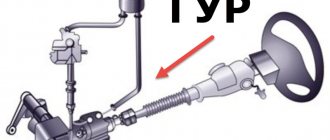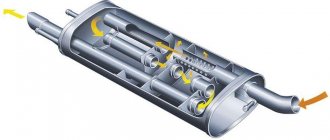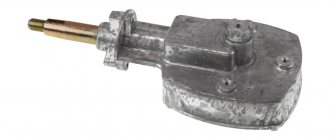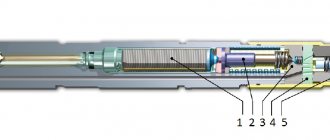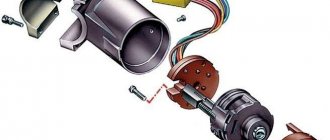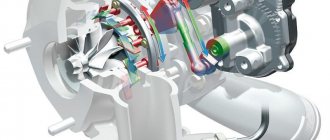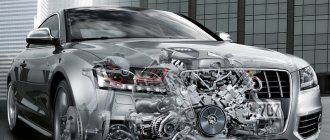AFS (Active Front Steering) is an active steering system, which is essentially an improved classic steering system. The main purpose of AFS is the correct distribution of force between all components of the steering system, and the main goal is to improve the efficiency of driving at various speeds. The driver, if the car has active steering, receives increased comfort and confidence in driving. Let's consider the principle of operation, the AFS device, as well as its differences from the classic steering system.
What is active steering
Active steering is essentially a modified version of conventional steering. The presence of this system on board the car helps to improve dynamic characteristics, better control of the car, and also improves comfort. The AFS (Active Steering) system was first installed in 2003 on top-end BMW models.
In more detail, active steering can change the ratio between the steering wheel and the steering mechanism, depending on the speed of travel. In addition, the system can independently adjust the angle of rotation of the front wheels when entering a turn or braking on a slippery road. In addition, the active steering system can steer the rear wheels, thereby increasing the vehicle's maneuverability.
History of origin
The system was developed by Bosh and ZF. Currently, such a system is a proprietary attribute of BMW cars.
The development of AFS took a lot of time and money. However, such a system would not be possible without the use of hydraulic power steering. For this we should thank the American Francis Davis. In 1925, he patented a prototype hydraulic booster. The system was later modified using an electric motor to regulate hydraulic pressure. It is this type of electric power steering that realizes the capabilities of the active steering system.
In addition to the hydraulic booster, the exchange rate stability system or ESP plays an important role. This system records data from sensors and allows the car to maintain a given trajectory in difficult driving situations. Used since 1995.
Having power steering and ESP in their arsenal, the Bavarians were able to design an active steering system that has been installed on BMW cars since 2003. Similar systems are found on other cars, for example, on the Honda S2000.
How the system works
Active Steering is activated when the engine is started. The system works by changing the steering gear ratio depending on the speed and driving conditions.
When performing maneuvers at low speed, the electric motor turns on in accordance with the signal from the steering angle sensor. The electric motor transmits rotation through a worm pair to the epicyclic gear of the planetary gearbox. Rotating the gear in a certain direction at maximum speed provides the smallest steering gear ratio, which reaches a value of 1:10. At the same time, the steering wheel becomes sharp, the number of rotations of the steering wheel from lock to lock is reduced, thereby achieving high driving comfort.
As the driving speed increases, turning is accompanied by a decrease in the rotation speed of the electric motor, and the steering gear ratio increases accordingly. At speeds of 180-200 km/h, the gear ratio reaches the optimal value of 1:18. At the same time, the electric motor stops rotating, and the force from the steering wheel is transmitted directly to the steering mechanism.
With a further increase in speed, the electric motor turns on again, while rotating in the opposite direction. The steering gear ratio can reach 1:20. At this gear ratio, the steering has the least sharpness, the number of rotations of the steering wheel from lock to lock increases, thereby ensuring safe maneuvering at high speeds.
If, when cornering, the car is oversteering (loss of traction of the rear wheels with the road), the AFS system, based on signals from the DSC system sensors, independently corrects the angle of rotation of the front wheels. As a result, the vehicle's directional stability is maintained. In the event that the active steering system cannot fully ensure vehicle stability, the dynamic stabilization system is activated.
Likewise, Active Steering stabilizes the vehicle when braking on slippery surfaces, thereby increasing the effectiveness of the ABS anti-lock braking system and reducing braking distances.
Active Steering is always on and cannot be switched off.
Repair of BMW E63 with Active Front Steering (AFS)
The diagram was prepared based on materials from SAE International.
- power steering pump
- hoses
- reservoir for working fluid
- electronic control unit
- data bus
- electric motor
- motor rotation angle sensor
- Servotronic valve
- planetary reductor
- emergency lock
- total rotation angle sensor
- steering gear.
The AFS system is a joint development of Bosch and ZF . Currently, the system is installed on most BMW as an option and is a proprietary attribute of this brand. The competitive advantages of this system are increased comfort and safety during vehicle operation.
The active steering system interacts with other systems in its operation, incl. with Servotronic power steering, DSC dynamic stabilization system.
The AFS system has the following general design:
- planetary reductor;
- control system.
Active steering system diagram.
The planetary gearbox is used to change the speed of rotation of the steering shaft. It is installed on the steering shaft. The planetary gearbox includes a sun gear, a planetary gear unit and a ring (epicyclic) gear. At the input, the steering shaft is connected to the sun gear, at the output - to the satellite block.
The epicyclic gear is rotatable. When the gear is stationary, the gear ratio of the planetary gearbox is equal to one and the steering shaft transmits rotation directly. Rotation of the epicyclic gear in one direction or the other allows you to increase or decrease the gear ratio of the planetary gear, thereby achieving a change in the gear ratio of the steering mechanism. The rotation of the gear is ensured by an electric motor connected to its outer side via a worm gear.
To implement the functions of the active steering system, a control system . The electronic control system includes the following elements:
- input sensors;
- electronic control unit;
- actuators.
Input sensors are designed to measure system operating parameters and convert them into electrical signals. The AFS system uses the following sensors in its operation:
- motor position sensor;
- total rotation angle sensor;
- steering angle sensor;
- sensors of the dynamic stabilization system (vehicle rotation speed around the vertical axis and vertical acceleration).
The total steering angle sensor may not be installed; in this case, the angle is calculated virtually based on the signals from other sensors.
The electronic control unit receives signals from sensors, processes them and, in accordance with the established algorithm, generates control actions on actuators. The electronic control unit has a connection and interacts with control units of other vehicle systems:
- Servotronic systems;
- dynamic stabilization systems DSC;
- engine control systems;
- car access systems.
The actuators of the AFS system are:
- electric motor;
- warning light on the instrument panel.
The electric motor rotates the epicyclic gear of the planetary gearbox. The electric motor is equipped with an emergency electromagnetic lock that blocks the worm gear. In the initial position, the transmission is blocked. When current is supplied to the electric motor, the electromagnet is activated, and the latch, overcoming the force of the spring, releases the rotor of the electric motor. If a malfunction occurs in the AFS system, the supply of current to the electric motor is stopped and the latch blocks the worm gear.
The occurrence of malfunctions in the system is accompanied by the activation of a warning lamp on the instrument panel. A self-diagnosis message appears on the information display.
How the active steering system works.
The AFS system is activated when the engine is started. The system works by changing the steering gear ratio depending on the speed and driving conditions.
When performing maneuvers at low speed, the electric motor turns on in accordance with the signal from the steering angle sensor. The electric motor transmits rotation through a worm pair to the epicyclic gear of the planetary gearbox. Rotating the gear in a certain direction at maximum speed provides the smallest steering gear ratio, which reaches a value of 1:10. At the same time, the steering wheel becomes sharp, the number of rotations of the steering wheel from lock to lock is reduced, thereby achieving high driving comfort .
As the driving speed increases, turning is accompanied by a decrease in the rotation speed of the electric motor, and the steering gear ratio increases accordingly. At speeds of 180-200 km/h, the gear ratio reaches the optimal value of 1:18. At the same time, the electric motor stops rotating, and the force from the steering wheel is transmitted directly to the steering mechanism.
With a further increase in speed, the electric motor turns on again, while rotating in the opposite direction. The steering gear ratio can reach 1:20. At this gear ratio, the steering has the least sharpness, the number of rotations of the steering wheel from lock to lock increases, thereby ensuring safe maneuvering at high speeds.
If, when cornering, the car is oversteering (loss of traction of the rear wheels with the road), the AFS system, based on signals from the DSC system sensors, independently corrects the angle of rotation of the front wheels. As a result, the vehicle's directional stability . In the event that the active steering system cannot fully ensure vehicle stability, the dynamic stabilization system is activated.
Similarly, the active steering system stabilizes the vehicle's motion when braking on slippery surfaces , thereby increasing the effectiveness of the ABS anti-lock braking system and reducing braking distances.
Active Steering is always on and cannot be switched off.
Repairing these systems is one of the most difficult compared to repairing other steering systems. The design of the rack is very complex and radically different from anything found on other cars.
In addition, the rack is equipped with complex electronics and sensors that are responsible for its operation. At the same time, all the rack electronics actively interact with other vehicle electronics.
An adaptation procedure is required during removal and installation.
Only the most experienced craftsmen undertake repairs of this complexity.
The qualifications of our service staff allow us to repair these systems with a quality guarantee. We'll do it quickly. Many of our clients have already been convinced that repairs in our company are carried out in accordance with factory standards and allow us to bring almost any rail back to life.
We guarantee results. You will pay only after your problem is resolved.
The warranty covers all our work for a period of 1 YEAR and without mileage restrictions. Therefore, you do not risk anything.
Want to solve your steering problems?
Call and make an appointment for diagnostics
by phone:
Active steering is also available on the BMW E 60
Active steering device
The design of the active steering system is not the simplest and at the same time combines several other safety systems. Nevertheless, experts identify the main parts that are responsible for turning the wheels and stabilizing them; other mechanisms are considered auxiliary, including steering the rear wheels. Among the main mechanisms are the steering rack, sensors, control unit, the steering wheel itself and steering rods. Now let’s take a closer look at what function each of the parts performs.
The entire activation process of the active steering mechanism begins with the input sensors. Regardless of the car model, they are designed to measure different parameters. For example, steering angle sensors, electric motor position, total rotation angle sensors, as well as vehicle dynamic stabilization sensors. Although, recently they have stopped using the total rotation sensor, taking information from other sensors of the car.
Having received the necessary information from the sensors, it enters the electronic control unit (ECU). We can say that this is the heart of the entire system and thanks to it, all active steering mechanisms are controlled. The task of the ECU is not difficult: to receive signals, process them and transmit them to actuators. Most of all, the electronic active steering wheel unit interacts with the electric power steering, the engine management system and the vehicle dynamic stabilization system.
After processing the information, the signals are sent to the steering rack, or rather the steering rack electric motor. Due to this, the system can independently decide how much to turn the rack in one direction or another. The electric motor itself rotates the ring gear, as a result of which the gear ratio of the mechanisms changes. As for the steering wheel and tie rods, they perform the same functions as in normal driving.
Car active steering diagram
Taking into account the complex design of the active steering mechanism, as well as understanding what certain parts are responsible for, we should consider the laughter of the mechanism.
The photo shows a diagram of the car's active steering
- steering angle sensor;
- steering wheel shaft;
- shaft gear;
- steering wheel torque sensor;
- electronic control unit;
- electric motor;
- rack;
- amplifier gear.
We can say that these are the main parts of the active steering system. In addition to the listed elements, the mechanism also includes a reservoir for working fluid, an emergency lock, connecting hoses, a gearbox and a system valve.
symptoms
A list of possible symptoms you may notice if the Active Steering module or one of its components fails.
- Fault message on the iDrive CCC/CIC screen Active steering is inactive
- The behavior of the steering wheel may change or the steering wheel may move.
- Steering wheel behavior has changed
- The steering wheel may be at an angle
- You can continue your journey
- Drive carefully
- Active steering error
The Active Steering warning light may come on after wheel alignment if performed by mechanics unfamiliar with BMW.
Power steering or electric power steering: advantages and disadvantages of power steering
The AFS system design combines a planetary gearbox and a control system.
The planetary gearbox is used to change the speed of rotation of the steering shaft. It is installed on the steering shaft. The planetary gearbox includes a sun gear, a planetary gear unit and a ring (epicyclic) gear. At the input, the steering shaft is connected to the sun gear, at the output - to the satellite block.
The epicyclic gear is rotatable. When the gear is stationary, the gear ratio of the planetary gearbox is equal to one and the steering shaft transmits rotation directly. Rotation of the epicyclic gear in one direction or the other allows you to increase or decrease the gear ratio of the planetary gear, thereby achieving a change in the gear ratio of the steering mechanism. The rotation of the gear is ensured by an electric motor connected to its outer side via a worm gear.
A control system has been created to implement the functions of the active steering system. The electronic control system includes input sensors, an electronic control unit and actuators.
Input sensors are designed to measure system operating parameters and convert them into electrical signals. The AFS system in its work uses sensors for the position of the electric motor, the total angle of rotation, the angle of rotation of the steering wheel, and sensors for the dynamic stabilization system (vehicle rotation speed around the vertical axis and vertical acceleration). The total steering angle sensor may not be installed; in this case, the angle is calculated virtually based on the signals from other sensors.
The electronic control unit receives signals from sensors, processes them and, in accordance with the established algorithm, generates control actions on actuators. The electronic control unit has a connection and interacts with other vehicle systems: Servotronic, DSC dynamic stabilization, engine control, vehicle access.
The electric motor acts as the actuator of the AFS system. It ensures the rotation of the epicyclic gear of the planetary gearbox. The electric motor is equipped with an emergency electromagnetic lock that blocks the worm gear. In the initial position, the transmission is blocked. When current is supplied to the electric motor, the electromagnet is activated, and the latch, overcoming the force of the spring, releases the rotor of the electric motor. If a malfunction occurs in the AFS system, the supply of current to the electric motor is stopped and the latch blocks the worm gear.
The occurrence of malfunctions in the system is accompanied by the activation of a warning light on the instrument panel. A self-diagnosis message appears on the information display.
Advantages and disadvantages of the AFS system
Like any mechanism, the active steering system has positive and negative sides. Despite the complexity of the mechanism, there are many more advantages, but there are practically no disadvantages. Among the positive aspects of the AFS system are light weight, increased reliability in operation, safety, and comfort.
There are practically no negative aspects to active steering systems, since the mechanism works flawlessly and rarely fails. If a failure does occur, and most often it is a failure or complete failure of the electronics, then you will not be able to fix it yourself. It is necessary to go to specialized services for repairing the AFS system.
Cost of repairs and parts for AFS
Today, the AFS system can be found not only on BMW cars. Most premium cars are equipped with this mechanism or offered as an option. For example, on Lexus cars the active steering system can be found most often.
As practice and reviews from car owners show, car body position sensors most often fail. No wonder, since the roads leave much to be desired and frequent body roll is simply inevitable. On average, the cost of replacing a sensor is about 150-175 dollars per 1 piece. Depending on the car model, there are at least 4 of them and more often they fail in pairs. The sensor itself will cost about $100-120, so 50% of the cost is the repair itself. The AFS electronic control unit will cost about 10,000 rubles. Repairing the steering rack will cost the most, on average about $1000.
Some car owners manage to replace the sensors themselves. We can say that this is the simplest thing in this mechanism and does not require special skills or tools. In addition, there are many tips and similar situations that are described in detail.
The active steering system, although a complex mechanism, without it, modern cars would not be as comfortable, and safety would be much lower. If it is possible to order the AFS system as an option, paying extra for it, then this will not be superfluous, and the difference in control will be noticeable from the first kilometers.
FAQ
How can you tell if a BMW has active steering?
- Many BMW owners often ask, “Does my BMW have active steering?” The best way to check if your BMW has active steering is to decode the VIN number. Use the free BMW VIN decoder and see if your BMW has AL active steering. BMWs that came with active steering include: E60, E61, E63, E64, E70, E81, E87, E90, E91, E92, E93.
Will I lose steering control if my BMW Active Steering fails?
- No. If your BMW Active Steering Motor fails, the Active Steering Motor automatically switches off in the locked position. When this happens, you rely on the mechanical connection between the steering wheel and the wheels. This causes the steering to function like a conventional system without the support of an active steering system.
Active car steering: what is the highlight of the BMW brand?
But, on the other hand, few people know that today there are several types of amplifiers, each of which has its own characteristics.
What is power steering for? Its task is not only to reduce the driver’s energy consumption when turning the steering wheel. This system makes the car more maneuverable, the impacts of the wheels on uneven roads are not transmitted to the driver’s hands in the same way, and, in the event of a tire puncture, it becomes easier to keep the car on the road.
So, today there are three main types of power steering - electric, electrohydraulic and hydraulic. The first cars had “hydraulics”, and it has not lost its relevance to this day. Over time, electro-hydraulic power steering appeared, and more recently, electric power steering.
Which one is more reliable? Which is better to give preference to? Let's look at each type in more detail.
Types of power steering
To make driving easier and improve comfort, engineers added power steering to the steering mechanism of the car. There are three main types of power steering: hydraulic power steering, electric power steering and electro-hydraulic power steering.
Hydraulic power steering (also known as power steering) is considered the most common among all existing ones. The main advantage is considered to be compactness, maintainability and simplicity of design. There is also a minus, it is constantly necessary to monitor the level of the working fluid.
The second option for power steering is electric (EUR). Today this is the most progressive mechanism; due to its design, it provides simple setup, reliable operation and is economical in fuel consumption (engine load). The main and huge advantage is the ability to drive a car without driver participation.
Read more: Lada Largus Cross 4x4 price photo video test drive and technical specifications
The last, third version of the power steering -
. It is based on the operating principle of a conventional hydraulic amplifier, but in this version, the pump is driven by an electric motor, and not by an internal combustion engine, as in the first version of the amplifier.
Due to the structure and various capabilities, the manufacturer can equip the control mechanism with an active steering system (AFS), dynamic or adaptive control.
Power steering
The power steering consists of several parts - pump, oil, hydraulic cylinder, connecting pipes and distributor. The main element of the system is a hydraulic cylinder, which is activated by a pump. At the same time, the necessary oil pressure is created in the hydraulic system, which exerts its effect on the steering rack piston and makes rotation of the steering wheel easier.
It is worth noting that constant operation of the hydraulic cylinder leads to an increase in vehicle fuel consumption. The weakest link in the entire system is the hydraulic tubes, which are often damaged.
Advantages of power steering:
- The action of the hydraulic booster leads to a decrease in the steering gear ratio, as well as to easier maneuvers;
- The force of impacts transmitted through the steering wheel to the driver’s hands is reduced;
- In unexpected circumstances, it becomes much easier to hold the steering wheel. The steering wheel does not break out of your hands, and controllability remains at a high level;
- Even if the hydraulic booster fails, you can be confident in driving safety;
- The management process is more informative and accurate.
Of the shortcomings, only one can be highlighted - increased fuel consumption.
Electric power steering
This system consists of an electric motor, mechanical transmission and control system. A special feature of the device is the creation of additional force when turning the steering wheel using a special electric drive. Many modern cars have just such an amplifier installed.
The principle of operation is based on the operation of a number of sensors that monitor the position of the steering wheel and the force exerted by the driver of the vehicle. When a certain signal is received from the system, the sensor transmits it to the control unit, where the signal is processed and transmitted to the electric motor placed in the steering wheel rack.
The peculiarity of electric power steering is that it ensures perfect vehicle control when driving at any speed, sharply returning the wheels to the center position or holding them in this place.
Advantages of an electric amplifier:
are compact, fuel saving, easy to set up and adjustable, minimal energy consumption, and the absence of hydraulic lines.
The disadvantages include:
probable failure or shutdown of the system in the event of emergency situations. Such problems are quite likely in the event of serious malfunctions in the operation of the control units, poor contact connections, or a decrease in voltage in the on-board network of the machine. If a malfunction occurs, the corresponding lamp on the dashboard should light up indicating the existing malfunction.
Power steering and electric power steering
In this mode, the electronic control unit generates signals, according to which the actuator (electric motor) generates a minimum torque. In this case, the concept of “heavy steering” occurs;
Related articles:
- Review of Nissan Qashqai 2 Nissan Qashqai is a front- or all-wheel drive SUV in the compact segment, combining stylish design, practical…
- GAZ 21 Putin A special lot has appeared on one of the online trading platforms: a GAZ-21 Volga car is being sold in St. Petersburg, which...
- KZ KAMAZ WHEELS Search and purchase of used KamAZ in Kazakhstan. We have been working with used KamAZ trucks for several years and...
- Audi 2006 I’ll probably start with the fact that it’s better to write good things or not write anything, so it would be more logical…
